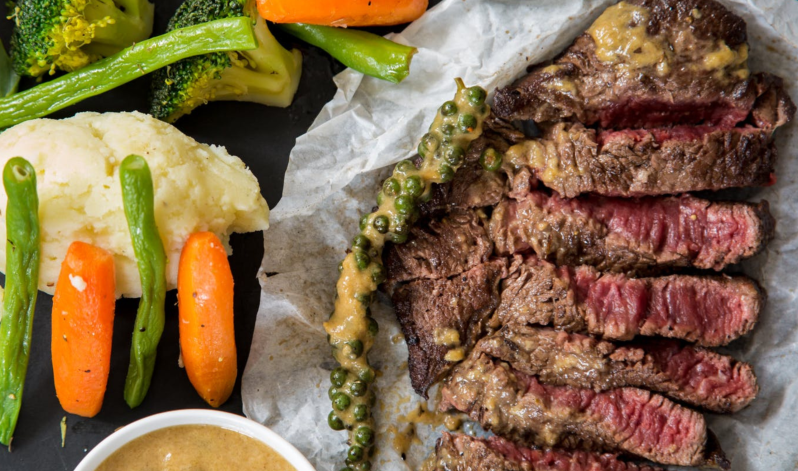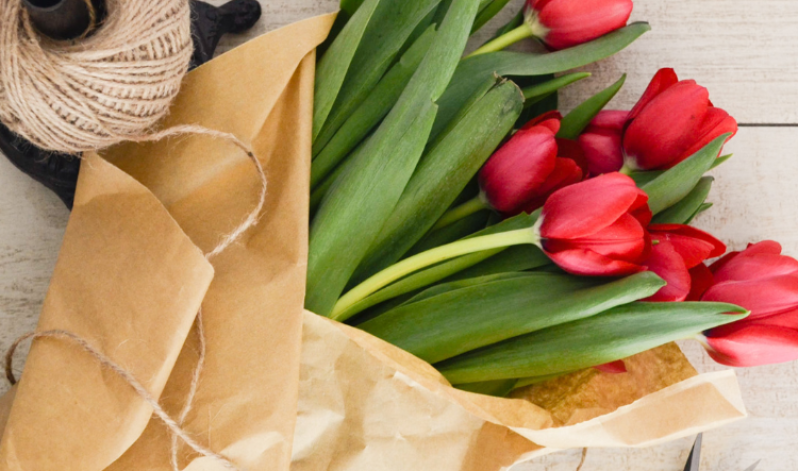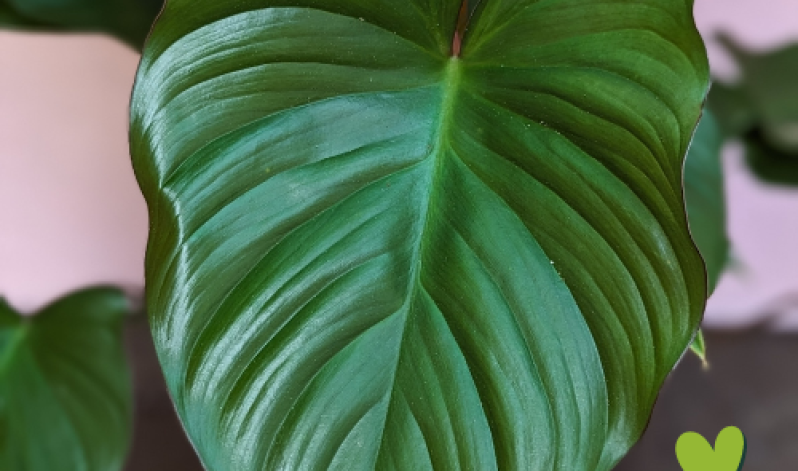Feb 08, 2024
0 comment
T-bone steak with black pepper butter
This recipe is from the BBC Good Food Show Summer 2022, as seen in the Big Kitchen by Tom Kerridge.
/*! elementor - v3.19.0 - 07-02-2024 */
.elementor-widget-image{text-align:center}.elementor-widget-image a{display:inline-block}.elementor-widget-image a img[src$=".svg"]{width:48px}.elementor-widget-image img{vertical-align:middle;display:inline-block}
This is the king of steaks! Caramelised on the outside, juicy and tender on the inside, you can’t beat a T-bone steak cooked on the barbecue. A colourful assortment of veg – cooked around the steak until tender and temptingly charred – is the perfect accompaniment.
Serves 3-4Ingredients1 T-bone steak (about 900g), atroom temperature1 tbsp vegetable oilBlack Pepper Butter:100g salted butter, softened1 tbsp Dijon mustardCharred VegI red onion, quartered1 white onion. quartered3-4 spring onions1 medium leek (white part only), split lengthways and halved 6long-stem broccoli spears1 lemon, cut in half2 thyme sprigs2 tsp vegetable oil
MethodFirst, prepare the black pepper butter.Mix the ingredients plus 2 tsp cracked black pepper and a pinch of salt together in a small bowl until evenly combined, then spoon onto the middle of a sheet of foil and roll to form a cylinder, roughly the diameter of a £1 coin. Twist the ends of the foil to seal and put in the fridge for 30 mins to firm up.Meanwhile, for the charred veg, put all the onions in a large bowl with the leek, broccoli, lemon and thyme. Drizzle with the oil and season with a little salt and pepper.When ready to cook, rub the T-bone steak with the oil and 1 tsp salt, then lay on a hot barbecue grid and cook for 5 mins.Using a pair of tongs, turn the steak over and cook for another 5 mins.Quickly place the onion wedges around the steak and cook, turning occasionally, for 5 mins. Now lay the leek, spring onions, broccoli and lemon halves on the grid and scatter over the thyme sprigs. Cook until the veg is tender and charred on both sides, turning as necessary.Once the steak is cooked, lift it off the barbecue and onto a warmed platter.Cover the steak with an upturned bowl to keep it warm and leave to rest for8 mins. Meanwhile, unwrap the black pepper butter and slice into discs, the thickness of a £1 coin.Carve the steak either side of the T-bone and place on a warmed platter or board.Lay the butter discs on top of the steak.Serve with the barbecued veggies and the charred lemons for squeezing over.
/*! elementor - v3.19.0 - 07-02-2024 */
.elementor-column .elementor-spacer-inner{height:var(--spacer-size)}.e-con{--container-widget-width:100%}.e-con-inner>.elementor-widget-spacer,.e-con>.elementor-widget-spacer{width:var(--container-widget-width,var(--spacer-size));--align-self:var(--container-widget-align-self,initial);--flex-shrink:0}.e-con-inner>.elementor-widget-spacer>.elementor-widget-container,.e-con>.elementor-widget-spacer>.elementor-widget-container{height:100%;width:100%}.e-con-inner>.elementor-widget-spacer>.elementor-widget-container>.elementor-spacer,.e-con>.elementor-widget-spacer>.elementor-widget-container>.elementor-spacer{height:100%}.e-con-inner>.elementor-widget-spacer>.elementor-widget-container>.elementor-spacer>.elementor-spacer-inner,.e-con>.elementor-widget-spacer>.elementor-widget-container>.elementor-spacer>.elementor-spacer-inner{height:var(--container-widget-height,var(--spacer-size))}.e-con-inner>.elementor-widget-spacer.elementor-widget-empty,.e-con>.elementor-widget-spacer.elementor-widget-empty{position:relative;min-height:22px;min-width:22px}.e-con-inner>.elementor-widget-spacer.elementor-widget-empty .elementor-widget-empty-icon,.e-con>.elementor-widget-spacer.elementor-widget-empty .elementor-widget-empty-icon{position:absolute;top:0;bottom:0;left:0;right:0;margin:auto;padding:0;width:22px;height:22px}
Grow your own leeks
To grow leeks, sow seeds in spring in peat-free compost. Keep them moist, then transplant in summer, either individually or in clumps. Harvest from autumn through spring. Alternatively, sow directly into prepared soil or buy seedlings.
Sowing & care
For optimal growth, plant leeks in a sunny, sheltered area with well-drained soil enriched with manure or fertilizer. Use a dibber to create 20cm deep holes for seedlings, watering them in for robust growth. Alternatively, plant in small clumps. Monty Don demonstrates another method, focusing on harvesting flavourful small plants. Space clumps appropriately and maintain moisture through watering and mulching while keeping weeds at bay.
Harvest
Your leeks will be ripe for harvesting starting from summer, depending on the variety. Lift them with a fork either individually or in clusters, being careful not to disrupt nearby plants. Leeks can remain in the soil until needed and will keep well in the fridge or a cool pantry for up to a couple of weeks after harvesting.
BOOK BBC GARDENERS' WORLD LIVE TICKETS
BOOK SPRING FAIR TICKETS
/*! elementor - v3.19.0 - 07-02-2024 */
.elementor-widget-divider{--divider-border-style:none;--divider-border-width:1px;--divider-color:#0c0d0e;--divider-icon-size:20px;--divider-element-spacing:10px;--divider-pattern-height:24px;--divider-pattern-size:20px;--divider-pattern-url:none;--divider-pattern-repeat:repeat-x}.elementor-widget-divider .elementor-divider{display:flex}.elementor-widget-divider .elementor-divider__text{font-size:15px;line-height:1;max-width:95%}.elementor-widget-divider .elementor-divider__element{margin:0 var(--divider-element-spacing);flex-shrink:0}.elementor-widget-divider .elementor-icon{font-size:var(--divider-icon-size)}.elementor-widget-divider .elementor-divider-separator{display:flex;margin:0;direction:ltr}.elementor-widget-divider--view-line_icon .elementor-divider-separator,.elementor-widget-divider--view-line_text .elementor-divider-separator{align-items:center}.elementor-widget-divider--view-line_icon .elementor-divider-separator:after,.elementor-widget-divider--view-line_icon .elementor-divider-separator:before,.elementor-widget-divider--view-line_text .elementor-divider-separator:after,.elementor-widget-divider--view-line_text .elementor-divider-separator:before{display:block;content:"";border-block-end:0;flex-grow:1;border-block-start:var(--divider-border-width) var(--divider-border-style) var(--divider-color)}.elementor-widget-divider--element-align-left .elementor-divider .elementor-divider-separator>.elementor-divider__svg:first-of-type{flex-grow:0;flex-shrink:100}.elementor-widget-divider--element-align-left .elementor-divider-separator:before{content:none}.elementor-widget-divider--element-align-left .elementor-divider__element{margin-left:0}.elementor-widget-divider--element-align-right .elementor-divider .elementor-divider-separator>.elementor-divider__svg:last-of-type{flex-grow:0;flex-shrink:100}.elementor-widget-divider--element-align-right .elementor-divider-separator:after{content:none}.elementor-widget-divider--element-align-right .elementor-divider__element{margin-right:0}.elementor-widget-divider--element-align-start .elementor-divider .elementor-divider-separator>.elementor-divider__svg:first-of-type{flex-grow:0;flex-shrink:100}.elementor-widget-divider--element-align-start .elementor-divider-separator:before{content:none}.elementor-widget-divider--element-align-start .elementor-divider__element{margin-inline-start:0}.elementor-widget-divider--element-align-end .elementor-divider .elementor-divider-separator>.elementor-divider__svg:last-of-type{flex-grow:0;flex-shrink:100}.elementor-widget-divider--element-align-end .elementor-divider-separator:after{content:none}.elementor-widget-divider--element-align-end .elementor-divider__element{margin-inline-end:0}.elementor-widget-divider:not(.elementor-widget-divider--view-line_text):not(.elementor-widget-divider--view-line_icon) .elementor-divider-separator{border-block-start:var(--divider-border-width) var(--divider-border-style) var(--divider-color)}.elementor-widget-divider--separator-type-pattern{--divider-border-style:none}.elementor-widget-divider--separator-type-pattern.elementor-widget-divider--view-line .elementor-divider-separator,.elementor-widget-divider--separator-type-pattern:not(.elementor-widget-divider--view-line) .elementor-divider-separator:after,.elementor-widget-divider--separator-type-pattern:not(.elementor-widget-divider--view-line) .elementor-divider-separator:before,.elementor-widget-divider--separator-type-pattern:not([class*=elementor-widget-divider--view]) .elementor-divider-separator{width:100%;min-height:var(--divider-pattern-height);-webkit-mask-size:var(--divider-pattern-size) 100%;mask-size:var(--divider-pattern-size) 100%;-webkit-mask-repeat:var(--divider-pattern-repeat);mask-repeat:var(--divider-pattern-repeat);background-color:var(--divider-color);-webkit-mask-image:var(--divider-pattern-url);mask-image:var(--divider-pattern-url)}.elementor-widget-divider--no-spacing{--divider-pattern-size:auto}.elementor-widget-divider--bg-round{--divider-pattern-repeat:round}.rtl .elementor-widget-divider .elementor-divider__text{direction:rtl}.e-con-inner>.elementor-widget-divider,.e-con>.elementor-widget-divider{width:var(--container-widget-width,100%);--flex-grow:var(--container-widget-flex-grow)}
Find more grow your own recipes
Find out more about the Fair



